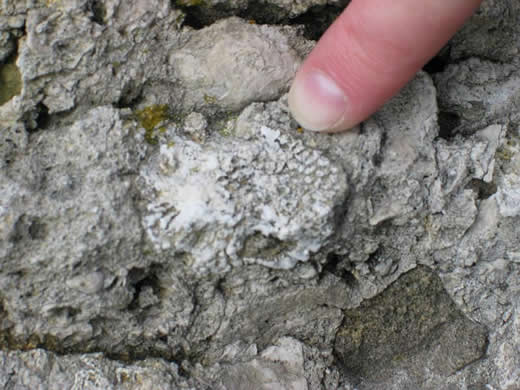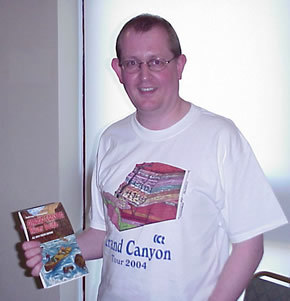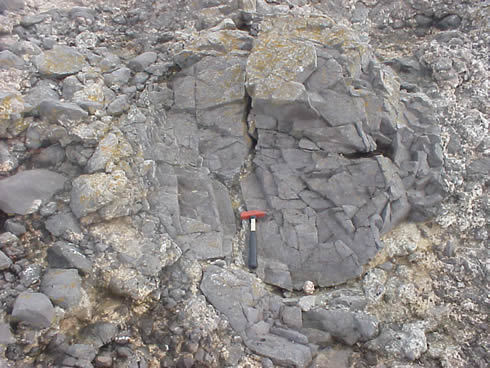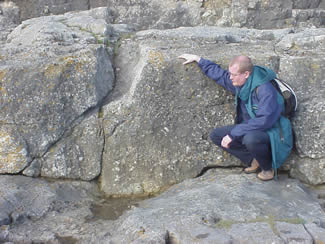
The 4th Geology Workshop was held in Bridgend, South Wales, 18-19 September 2004. The fieldwork day considered the coastal section by Ogmore-by-Sea and Southerndown.
David Tyler revisited the “Sutton Stone controversy”. This was initiated by Derek Ager, Professor of Geology at Swansea University, when he reinterpreted the basal conglomerate of the Jurassic of South Wales as a mass flow deposit, laid down one “Tuesday afternoon”. (For more on the background to this, please click here). The rationale for Ager’s interpretation and the published criticisms of his view were considered in some detail. The conclusion was that Ager’s arguments were valid, but that there are several aspects of the geology requiring further work. The fieldwork on the following day was intended as a follow-up to this presentation.

The Sutton Stone. This conglomerate is about 1.2 m thick, with matrix-supported clasts. All the fossils in this unit are in a fragmentary state – as is the case with the coral in this picture.
Paul Garner spoke on the 2004 ICR Grand Canyon raft tour. His first presentation took us through the six-day trip, starting with the journey to the raft launching site, through the Canyon to Phantom Ranch, and then up the Bright Angel Trail to the “Victory Dinner”. This adventure was described in graphic detail and it was obvious that the experience could be described as a “trip of a lifetime”.

Paul Garner with ICR T-shirt and trail guide.
Paul’s second presentation concerned the geology of Grand Canyon, bringing out some of the take-home messages from Steve Austin and Andrew Snelling (the ICR geologists leading the trip). In particular, we heard about the research into the mass-kill of nautiloids in a particular bed of the Redwall Limestone, with numerous illustrations of the localities and the fossils. An initial presentation of this research was made to the International Conference on Creationism in 2004. For further reading from ICR, please click here.
Last in Paul’s trilogy was a 30-minute DVD of the river trip made by a camera crew that travelled with the party. This gave further insights into the scenery, the geology and the positive reactions of the participants.
The next topic to be considered at the Workshop concerned recent work on depositional environments in Cambrian strata. Strong linkages have been identified between the organisms living in the sediments and the character of the sedimentary environments. This situation has been noted in many other localities, particularly involving trace fossil studies. The implication is that environments are the primary control on fossil assemblages, and evolutionary factors are of secondary importance. Links were also made with the Recolonisation approach to understanding geological successions and Earth history.
Finally, Richard Johnston led a workshop discussion on Recolonisation and Earth history. This considered the biblical framework, the biological framework and the geological framework for scholarly activity in these areas. It was agreed to prepare a visual overview of a Recolonisation approach to Earth history that could be affirmed by those participating in the discussion.
The field excursion morning was spent looking at the Upper Triassic conglomerates resting on a Carboniferous unconformity at Ogmore-by-Sea. These conglomerates are clast-supported and coarse – with numerous clasts over a metre in diameter and some many metres across. Others have been willing to describe these rocks as a succession of “Tuesday afternoon” events, but we thought that some of the clasts were just too large to be carried by temporary flash floods. Mechanisms to generate and shift these enormous boulders still await identification. We noted the evidences for these deposits being in channels: the larger of the sections is in a shallow channel and the smaller section is channelised with very steep sides. The Carboniferous Limestone is, in places, highly fractured and easily broken up. Mineralising fluids have moved through the limestone and, in some cases, through the conglomerates also. We asked ourselves about evidences for substantial Triassic relief (in the form of high hills that could be eroded to form fanglomerates) but could not identify any. Consequently, we explored the idea that faulting and fracturing generated the breccia. We noted that the steep sides of the smaller channel is consistent with rapid erosion and deposition.

Large clast in the Upper Triassic conglomerates near Ogmore-by-Sea.
The afternoon excursion took us to the Sutton Stone, a 1.2 m thick sheet conglomerate at the base of the Jurassic succession in this area. The overlying rocks are bedded limestones, often with pea-sized clasts scattered sparsely in a finer-grained matrix. The only coarse conglomerates are at the base of the sequence examined. We identified evidences of time for the unconformity to become encrusted with small coral colonies and bored by very small organisms (to form the trace fossil known as Trypanites). The surface topography of the unconformity was much discussed (with a critical evaluation of the tidal erosion model proposed in 1988).

Paul Garner examines the Sutton Stone and the (alleged) tidal channel and ridge topography of the unconformity surface.
We gave particular attention to the stepped topography of the unconformity near a locality called Pant y Slade. We identified some significant differences between the rocks here and the published section – differences that have a bearing on the interpretative model. Our discussions also considered possible similarities between the channels in the Ogmore-by-Sea section and the topography of the Pant y Slade section. Several research questions have been identified, all of which were stimulated by a recolonisation approach to geological successions.
Report dated September 2004

